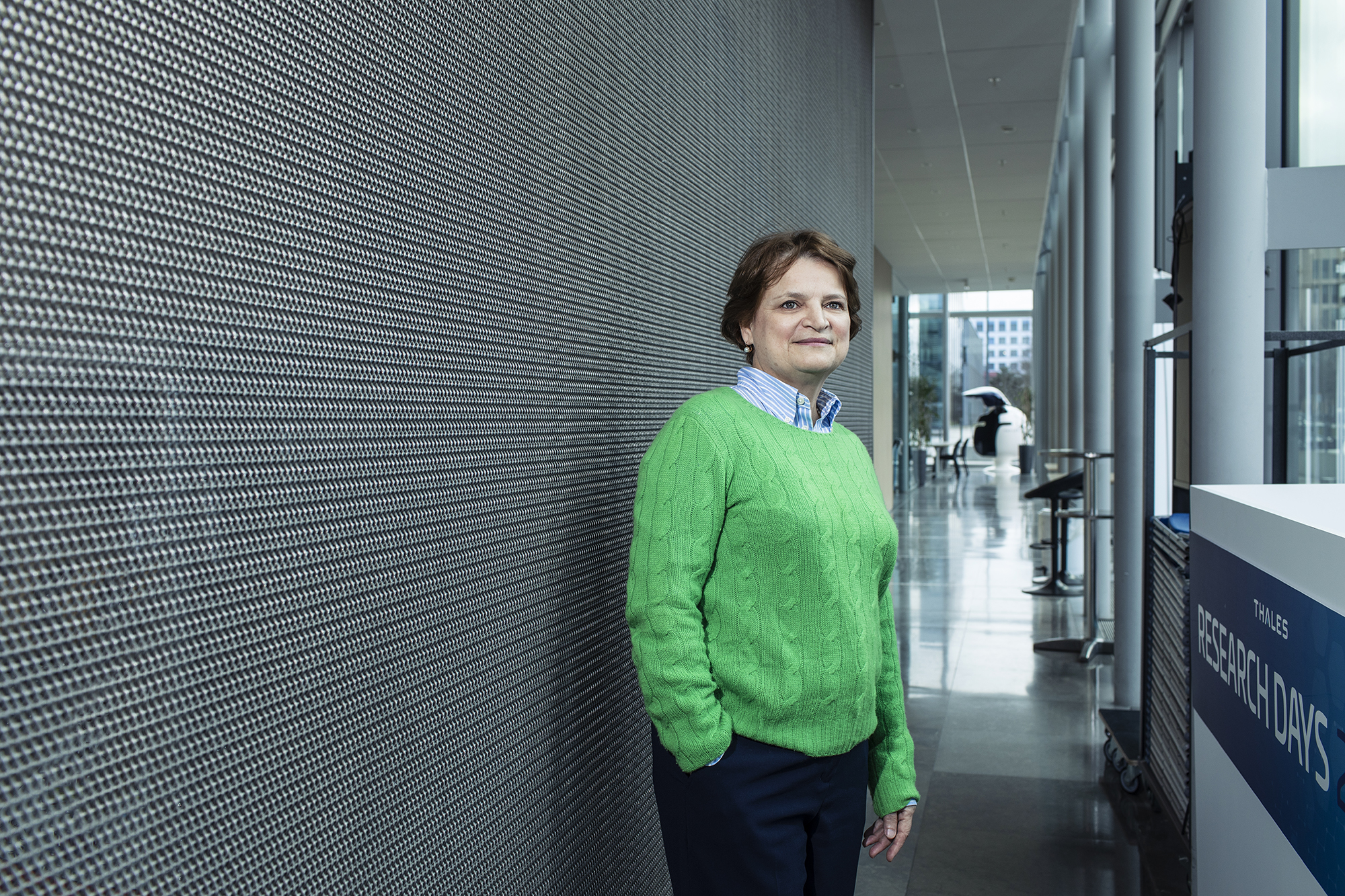"With 6G, science fiction is about to become reality!"
Farther, faster. With ultra-high speeds and near-instantaneous transmission, 5G not only boosts performance, it ushers in a digital revolution and enables new use cases in the commercial world and for the military. Hélène Bachatène, VP Research, Technology & Innovation, explains why Thales has such a pivotal role in this new ecosystem and why we need to think now about 6G, planned for 2030.

Today, we’ve reached the fifth generation of network standards for mobile telephony, from 1G in 1980, which allowed the first analogue wireless transmission, to 4G, which considerably increased connection speeds. Why the need for this new step forward with 5G?
By offering even higher data rates — up to 100 times faster than initial 4G networks — reducing latency and limiting the risk of network saturation, 5G has significantly increased performance to the level needed for mission-critical systems applications, such as in medicine and military theatres of operations. But that’s not all.
5G is a paradigm shift, because it allows network softwarisation (see box 1) at a time when the cloud and software are revolutionising the telecoms industry. Indeed, 5G is inseparable from the advent of the Internet of Things, which allows our physical devices to communicate with each other and their digital twins.
Today, there are more than 500 million connected devices around the world, which all need to share information efficiently to enable these data-driven architectures to function. In this new ecosystem, only 5G can deliver a fully satisfactory level of performance.
Thales CTO Bernhard Quendt has identified 5G/6G as one of the disruptive technologies set to revolutionise our daily lives and in which Thales intends to invest especially heavily. Why is it such an important technology for the company?
First, because the future applications promised by 5G/6G will have a major impact on the architectures we’re currently designing for our civil and defence customers.
Thales has no intention to become a network operator in charge of rolling out 5G/6G in France or Europe. Our role is to help our customers prepare for the future. We need to ensure they always have the world-class connectivity and applications they need in the decades ahead. We operate in a fast-paced tech industry where we need to be constantly thinking ahead of the curve. The imperative is always the same: ensure the security of data and complex systems at a time when networks are increasingly fragmented. For this reason, we can’t rest on our laurels with existing standards.
The imperative is always the same: ensure the security of data and complex systems at a time when networks are increasingly fragmented.
Is that why Thales has engaged with Beyond 5G?
Yes, we’re involved in this collaborative project (see box 2) because more than ever cybersecurity is a necessary precondition of our sovereignty. Beyond 5G will give organisations greater control over their security by letting them set their own parameters and free themselves from reliance on providers and operators.
But there’s another challenge ahead: we need to adapt to the imminent emergence of quantum technologies and supercomputers, which represent a potential threat to security, due to their sheer processing power. Our commitment to Beyond 5G is a reminder that Thales never waits for a new level to be reached. Rather, we develop our solutions ahead of time. This is also reflected in our involvement in intermediate 4G LTE (Long Term Evolution) technologies, which today enable soldiers, for example, to share data more easily and securely in a theatre of operations.
We’re always looking beyond the standards currently being sold. Change is permanent: one generation always paves the way for the next. And this is especially true with 5G and 6G.
What are the benefits of 5G?
The real merits of fifth-generation networks aren’t found in the services offered by civil operators today. Plus, 5G isn’t yet widely rolled out in France or Europe, compared with the United States and China, which are the driving forces of this technology.
5G has demonstrated it’s possible to develop private networks for industry with the necessary connection speeds and security. Another benefit is network slicing. In other words, the ability to use the same physical architecture but “slice” it into multiple virtual networks. Each slice can then be configured with its own quality-of-service criteria, such as security.
This is important for Thales and its activities, especially because military law has different levels of classification and requirements for the data on its networks.
Has 5G lived up to its promises?
Yes it has, in many respects — speeds up to 10 Gbit per second, 1,000 times more bandwidth per unit area, 100% coverage, drastically reduced network power consumption and excellent battery life for energy-efficient IoT devices.
But one aspect in particular still needs improvement, namely latency. The target set by 5G standards was 10 milliseconds. The average human reaction time to a visual stimulus is 250 ms, or a quarter of a second. So, imagine the extraordinary potential of a car, for example, fitted with an onboard system capable of reacting 25 times faster than us, while responding to incoming information and relaying its responses to other vehicles to the nearest 10 milliseconds. We’re not there yet. Which is why 5G should be seen not as an end in itself, but as a necessary step in the ongoing evolution of mobile networks, ahead of 6G.
Have we entered an age of immediacy?
The crucial challenge is to achieve infinitesimally low latency and the shortest data processing time in order to provide stakeholders with the best possible decision support.
For military users, we could foresee a move to near-real time, which will allow for almost instant decisions. But the evolution of network standards needs to be coupled with AI and the defence cloud, so the network learns from previous tasks to improve service with future requests.
As with the question of immediacy, our teams are busy working on autonomic management. This refers to the ability of networks to use AI and machine learning to dynamically adapt and self-configure so they can offer the best possible performance while limiting the consumption of technological and human resources.
Our researchers are working hard on techniques that will eventually enable communication networks to autonomously identify and solve problems and optimise their use of resources according to mission requirements.
Our expertise in the field of autonomous networks could be a major asset for Europe in the race to 6G. Thales is making this argument as part of the Hexa-X project, launched in late 2020 by Nokia to lay the foundations for the pre-standardisation of future mobile communications.

Does Thales’s know-how and experience play a part in setting new communication standards?
Until now, access to mobile networks from a user terminal required terrestrial access points. One of Thales’s major achievements, under the leadership of Thales Alenia Space, was to push for the integration of non-terrestrial networks (NTNs), including satellite networks, into the 3GPP (3rd Generation Partnership Project) 5G-6G standard, which coordinates cooperation between telecoms and standards bodies.
It will then be possible to directly access the 5G or 6G mobile network with the same terminal, whether via a terrestrial or non-terrestrial relay (low-Earth orbit satellites, high-altitude platforms, drones). These non-terrestrial or 3D components will seamlessly complement and/or supplement network coverage with Beyond 5G, then 6G.
Why is the rollout of 6G not planned before 2030?
One generation of mobile networks typically runs for 10 years. We’re currently at 5G. And to meet the ambitious goals of 6G, a number of technical hurdles need to be overcome, not least the question of materials.
The transition to terahertz (THz) frequencies calls for state-of-the-art materials, which are currently being developed. The more material you use to deliver high-frequency performance, the greater the issues around energy dissipation. Tests are being conducted today on graphene and metamaterials, which will play a vitally important role for thermal, optical, electrical and electronic functions.
We can also expect to see greater demand for III-V semiconductors, which are widely used in 5G. The question of materials is crucial, because it determines the technical feasibility of the phenomenal potential of 6G.
So, what exactly will 6G offer?
Its applications defy the imagination, offering both virtual and physical experiences. With 100 Gigabits per second, 6G will take us into the realm of the instantaneous.
It’s hard to grasp all the benefits sixth generation will soon offer in e-health, transport, logistics, robotics and cybersecurity. But one thing is certain: we’re moving from science fiction to science reality.
We’ll be able to create digital twins in the cloud and interconnected at high speed, which will allow us to explore the real world beyond the constraints of space and time. As an industry specialist, it’s fascinating. Imagine being able to offer solutions or solve problems live in an immersive environment and create digital replicas of real objects for monitoring, diagnostics and prognostics.
Augmented reality and holograms, which are still in their infancy today, will also reveal their full potential. 6G will tie together the human, physical and digital worlds: research is currently focusing on ways to taste, smell and even touch objects via the network. You may have heard it said: 6G will usher in the “internet of the senses”!
While 5G is paving the way today, 6G will open a whole new realm of possibilities for digital applications.
Mobile holograms, digital avatars… What next, teleport machines?
We’re not there yet, but never say never! While 5G is paving the way today, 6G will open a whole new realm of possibilities for digital applications, as reflected in the current dash for patents.
The rivalry between the major powers for 6G serves as a reminder: it’s critically important for both technological sovereignty and leadership. For three years now, Thales has been more mobilised than ever around these issues, responding to requests from the French government and Europe.
We’ve even carried out a demonstration for NATO on the risks and benefits of future mobile connectivity for cybersecurity. We currently have teams working on the digital applications of 5G and 6G in various departments, from cybersecurity to space, and we’re constantly talking to customers so we can understand their expectations and the issues they face.
We’re always on the lookout for people who can grasp not just the communication side but also the broader ecosystem: systems, software, cybersecurity and connectivity.
The possibilities offered by 6G are extraordinary. It’s up to us to invent the applications of the future!


